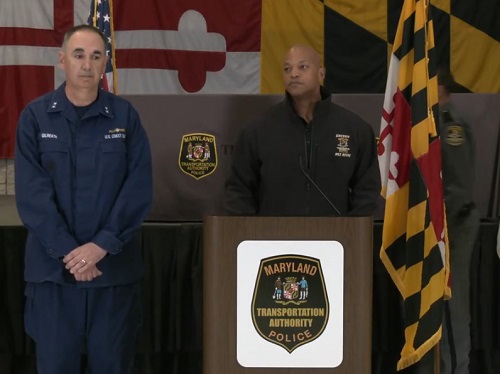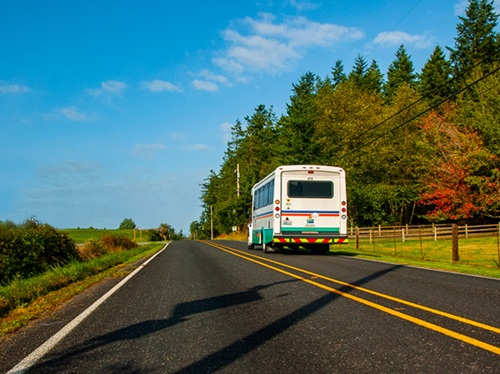Two shallow-draft shipping channels have been constructed to circumvent the wreckage of the Francis Scott Key Bridge, which collapsed after being struck by a container ship on March 26.
[Above photo by the Maryland DOT]
Built under the direction of the U.S. Coast Guard and U.S. Army Corps of Engineers, those channels are providing limited access in and out of the Port of Baltimore as the main waterway is gradually cleared of bridge debris.

“The channel depths for the northern alternate channel are 11 feet and for the southern alternate channel they’re 14 feet,” noted U.S. Coast Guard. Rear Admiral Shannon Gilreath in a press conference on April 3. “The commercial vessels that have transited through there are barges … and the tugs that push them, inbound and outbound from the port of Baltimore. So those two alternate channels are beginning to make a difference. There’s much more work to go, but those are again, small steps in a long marathon.”
Colonel Estee Pinchasin, the commander of the Baltimore District of the U.S. Army Corps of Engineers, said during the press conference that cargo containers are currently being removed from the ship that hit the bridge for storage at Sparrows Point.
“We’re still planning on removing that 3,000 to 4,000 ton span that’s resting on top of and leaning up against the vessel,” she explained.
“And we’re also planning to clear wreckage from the far side of the channel. What I mean by that is the far side away from where the vessel is grounded into the channel side … in order for us to allow us for some deeper [channel] traffic,” she added. “So as we get deeper into the channel on that far side and clear deeper wreckage from the far side of the channel, we’re hoping to be able to traffic larger vessels through.”

[Editor’s note: The U.S. Department of Transportation and Baltimore County recently signed a revised grant agreement to enable Tradepoint Atlantic or TPA, a facility in the county, to use a previously awarded $8.26 million USDOT grant to accommodate more cargo at TPA’s terminal on Sparrows Point at the Port of Baltimore. The TPA terminal is located outside the area affected by the bridge collapse and continues to move cargo. The USDOT also held, in conjunction with the National Economic Council, an East Coast port supply chain meeting on April 3 to discuss capacity concerns and other issues caused by the suspension of vessel traffic into and out of the Baltimore’s port.]
Maryland Governor Wes Moore (D) described the bridge wreckage blocking the main access channel inside the Patapsco River as “absolutely staggering” and covers approximately a 700 foot area of the port’s 50-foot-deep main waterway.
“When you’re looking at how mangled this wreckage is, how collapsed this wreckage is, it begins to highlight the level and the challenge that we have in front of us when it comes to this recovery mission and to being able to open up these elements of the ports,” he said.

Gov. Moore noted that he had been briefed by the Maryland Department of the Environment, which has performed water sampling upriver and downriver from the collapsed site.
“Their samples have revealed that there are no contaminants, including fuel, and the continued examination and the continued operations of being able to test the water will continue throughout,” he said.
The governor noted that the main priority now is to clear the bridge wreckage away and reopen the port.
But he stressed that his administration is also developing transportation options to compensate for the loss of the bridge.
“We are basically looking at transit options, getting people to ride-share, and things of that sort to try to bring down some of the [traffic] demand,” he said. “We are [also] reviewing the bottlenecks where we’re looking at our traffic signaling system, for instance, signage and things of that. Major construction, obviously it takes time, so we have to do these softer things first, but then focus on the larger project of rebuilding the bridge.”
 Top Stories
Top Stories
Modal Administrators Speak at AASHTO Annual Meeting
December 5, 2025 Top Stories
Top Stories

